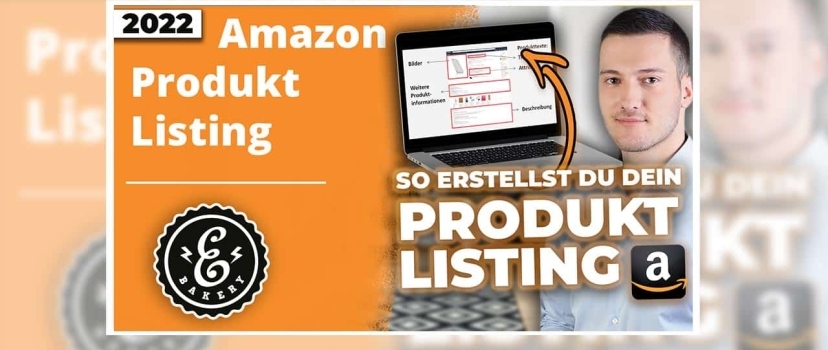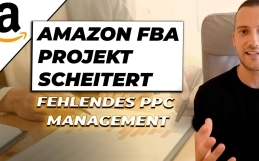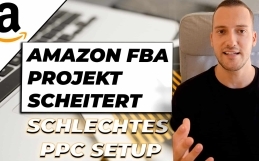Amazon Product Listing
How to create your first product on Amazon
In this Amazon Product Listing Tutorial, Lorenz from eBakery gives you an overview of how you should create your first product on Amazon. Especially the product images play a primary role. In the video, you can find out what exactly needs to be taken into account.
Amazon Product Listing - What's involved?
Topic Product Listing: we had already talked in the last video about Trademarks registration and we had shown that there are different ways to sell on Amazon under your own brand, either without a brand, with a brand that is not registered in the DPMA, or with an officially registered trademark in the German Patent and Trademark Office. Now this video is a bit related to the third option, meaning in the best case you have virtually registered your trademark at the DPMA and can then create your product at Amazon. Now there are two different options and I would draw that up on the whiteboard. Step 1 – Trademark registered in DPMA. Meanwhile, it must be noted that Amazon also recognizes trademarks that are not yet fully registered, but are only in the application process. This means that you will have to wait an average of 3-6 months until the trademark is fully registered. Do not wait. It is also possible to link the trademark with the file number or the registration number in the DPMA already during the application at Amazon.
Brand Registry Login
This is then also the second step: Brand Registry Login. Amazon has brand registries for each market, brand registration registries so to speak, if you want to call it that. You use your Sellercentral access, log into the Brand Registry and then you can add your brand there. Then they ask for things like the name of the brand, the registration number in the DPMA, usually also which categories are relevant for your sales, whether barcodes exist and a photo of either the product or the packaging on which the branding – i.e. logo or brand name – can be seen and are permanently applied or attached. Means: we must definitely show in some way that our products or the boxes or the bags of the product have branding. You then have to submit the photo – Amazon I think in the Brand Registry is maybe even just a single photo – and then it usually takes one / two business days and the brand is linked at Brand Registry and can then relatively promptly also be used in Sellercentral, ie in the main account.
Amazon Product Listing - The Barcodes
What’s next? Here comes something with two possibilities: Barcodes. Let’s talk about this for a minute. Amazon gives you two different options here as a brand owner. We make times here these two options simply on it. Register or create products with EAN once, that is the first option or GTIN exemption, that is the second option. The first option is what most know, means we buy from GS1 a barcode set either one, or ten, or hundred. I think currently there are probably 10, 100 or 1,000 that you can buy. I’m not sure if there is currently one available, in any case we would buy barcodes quasi officially, then we would have to pay for the whole thing in GS1, connect that to the company, enter the product data and quasi create the barcodes for the product that way. This is relatively time-consuming. For most companies this is how it is done and that is fine, for newer sellers or general brand owners the second option is still available as well. This is an exemption of barcodes so to speak. Means we say to Amazon “Hey, we as brand owners don’t want to use barcodes, we want to be exempt from that”. This can be requested in the Seller Central account – takes 10 minutes or so – and usually goes through pretty quickly. This is now a very good option simply because in the catalog I say products often do not quite work with barcodes. This means that if we have a barcode and, for example, create a product incorrectly, it is very difficult to change things again afterwards. Or maybe another seller, let’s say “illegally” used our barcode before on Amazon, and now we can’t change it. There are many problems currently with products created with barcodes, so this second option with GTIN exemption is quite attractive.
Amazon Product Listing - Which option do you choose?
No matter which of the two you want to use, we can then sort of say, “Okay, we’ll use one of the two” and create the quote. Here we would then simply say “I want to create new listing on Amazon”. We set the category. Normally a lot of categories are already unlocked, but there are also categories for which you have to be unlocked, for example food, a lot of electronics stories, things in the health sector, baby products partly. If the category is simply free, we can select those. If the category is still locked, Amazon will tell you which documents you need for an activation, usually these are for example invoice or test documents for the products. However, this is also stated in the account. So we create the offer and then say primarily in the offer creation already times which category, what kind of product is that quasi, and it is also worthwhile here in the creation is offer already have all the data completely.
Means: for this we make the next page, we call it product creation, the following things should be in place now. EAN code, if you are not exempt from barcodes. The SKU (Stock Keeping Unit) is a value that you can set yourself under certain conditions. This is for your inventory holder, so virtually a code to each product that is easy for you to organize, used to classify the product. This is irrelevant for Amazon, they don’t use it much, but rather for you, so that you know what the product is, or maybe you have linked it with other tools and then it’s good if the SKU is the same on every marketplace – Ebay, Etsy, Walmart, Amazon – so that it all works in your inventory management system. But here you can also let Amazon and the SKU decide, which is then such a mix of numbers and letters, or you set it yourself – I would then recommend the case.
Determine the category
The next thing is – we have to say, of course, what category this is and also what subcategory. Now we can’t just say “kitchen”, “household”, “home”, we have to be very specific about which category the product is. Then we usually need: title, bullet points, description, backend keywords are very helpful, price, quantity and we need to say shipping by, so Amazon or us – in the case FBA, FBM – furthermore also country of origin in the normal case, so “Where was this produced?”. This is quite relevant for Amazon. What would also help are size and weight of the product, because most of you will be selling through Amazon FBA I assume, so it would be very good if you put in the product details now already bigger and weight. Later, when you send the product to Amazon, they will ask for it anyway, but it doesn’t hurt to do it now. And in the best case also the product images.
Amazon may ask for more data, you will see in the creation of the product all the fields highlighted in red you must enter. But these are the most important ones, I would say, that you would have to cover. The one big decision left: variants, yes or no?
Amazon Product Listing - Variant Item
If you have less than 10 variants, or up to 10 pieces, maybe that would be created in Sellercentral. More than 10 variants I would create per stock file. So that means, for products with a lot of variants – T-shirts for example, any things in the design area with many different designs, or sizes, colors, lengths, flavors, everything like that – with a lot of variants, it’s recommended to simply upload that per inventory file, that is, per Excel table, so to speak, because I’ll say that manually, by hand, in Sellercentral, it becomes very time-consuming and we also can’t define certain things there at all.
We create virtually all of our data. Very important: if your product has variants, please create it as a variant listing. You can see this directly in Seller Central then. Amazon now sometimes asks “Is it a variant product or not?” on the first page. And then it says “yes or no”. If it is not asked on the first page, there is a tab at the top called “Variants” or “Variation” and you can enter it there. Each variant is an independent product this is only put together as an offer in the catalog, then called Parent and Child, that also like in the video to stock file again look up, there we had mentioned that also once briefly.
Amazon Product Listing - Texts vs. Images
Now we have quasi already explained what we need, what is important, is that with the variants halfway clarified, now in the last part simply again on the subject of SEO and photos. So product texts quasi or SEO and on the other hand product photos / product images whatever you want to call it. Here it is quite important to understand what these things are good for and what they are not good for. New sellers in particular now sometimes have a bit of difficulty understanding exactly what these things are actually good for. Product texts, i.e. title, bullet points, description, backend keywords, everything that occurs in the text area, we primarily use for ranking or SEO.
Means: we use the texts not so much to sell the product, but rather for the algorithm on Amazon, so that Amazon recognizes what kind of product we sell – so what search terms are relevant for the product, where should our product be found, under what search terms and how should that be classified for the algorithm – that’s super important, because later we switch Advertising and if the listing cannot be recognized by Amazon at all well – text technically – the advertising may not convert very well and could possibly be more expensive or certain keywords may not be played out at all. We use SEO and the product text quasi quite strongly for ranking or that Amazon knows where we should rank.
What is important to keep in mind when it comes to product images?
The product photos primarily for conversions or the sales themselves. Customers meanwhile on Amazon – depending on course product group and price and so on – generally do not read too much. Means the title, bullet points, description is very often read similarly large, accordingly, we like to use the texts for ranking. The photos are nevertheless very strongly looked at. This is really the main selling point with many products the product photos. This means: we use the photos to sell the product, so that every customer who comes across our listing, whether through advertising or organically, converts in the best case and makes a purchase. The texts are only the basis for ranking and also later the PPC, that is the marketing. With the product photos – SEO we had already explained in another video, so now I’ll go into the photos – As a rule, that’s seven pieces. You can add more, but they won’t be visible on the listing unless the customer clicks on one of the images, goes to the gallery and then sees two or three more images. Seven pieces, so seven photos. First image is always the main image, also called Main Image and this is always with white background (product only). So that means: just a pure white background, only the product on it. There are some categories where this is not so especially “home decor”, so so furnishing stories quite often you see images / main images with non-white background. Normally, however, first picture simply the product with packaging, or without packaging. White background no editing. All other images are then for example lifestyle images, so quasi the product somehow in action, so to speak, shown in the real situation more or less. Infographics means the features of the product: size, weight, material, special features quasi also still like the use / quality or something, country of manufacture. Infographics can accommodate such things very well. We see comparisons again and again, especially with us supplements, something like that often happens, where they say our product and then it’s like a checklist of what it can do versus a third-party product and what they can’t do, so to speak. Comparisons often occur. These are the most “known ways”. Not recommended are always photos without editing, means what should we pay attention to now quasi: It should be all photos edited, not just with the cell phone somehow photograph the product, upload them times, that converts in the normal case not good. In the photos must be shown all the important features. That is, everything that should persuade the customer to buy quasi, or to persuade to buy, we should show the photos. Very important.
This is how the product images should look like
Furthermore, always use all the photos. What do I mean by that? We have these seven spots in the rulebook, we should fill those in. It is not good if an offer has only three photos, because we have potential which is not used in the end.
Correct resolution and size. What do I mean by that? 1000 x1000 pixel minimum and 1 : 1 format. This is still quite good to keep in mind. Amazon recommends these guidelines, means length and width or length and height of the product photos should be identical and it must be at least 1000 x 1000 pixels, so that the whole thing remains zoomable. So means: when the customer goes over it with the mouse he can always go further, or with the cursor, the product can automatically zoom, the product photo is zoomed, and that does not work under 1000 pixels. Very important to keep in mind. Other is videos. You can place multiple videos on a product, replaces the seventh image – I had said earlier there are seven images – when we upload a video, we have only six images + videos. When we upload multiple videos they’re not displayed next to each other, but the customer sees it, they can kind of see one video and underneath it kind of says there’s two more, there’s three more. Videos are very worthwhile. It’s always good to place those, both on the product and in the advertising and then clearly, you can again show the product in action, show features, even more so than on a picture. These are the most important things. To the SEO area you have already talked a bit what, to the topic there like to look at the other video. Here to create the photos quasi and to the product and the most important information. I hope this has helped you so far, and thank you. For watching stay tuned, there will definitely be more Amazon videos on all the important topics in the near future. But we have already created and uploaded a lot of things in the last weeks, so feel free to have a look in there as well.
Amazon agency eBakery
If you have any questions or if you want to leave the optimization to the professionals, please feel free to make an appointment with us. We are happy to help you as Amazon SEO agency, Amazon PPC agency, but also general Amazon agency.
Do you have questions or need an individual offer? Do not hesitate to contact us.
- 0/5
- 0 ratings
| Very bad! | Bad | Hmmm | Oke | Good! |
|---|---|---|---|---|
| 0% | 0% | 0% | 0% | 0% |
Haben Sie Fragen oder brauchen ein individuelles Angebot? Zögern Sie nicht, uns zu kontaktieren.



















